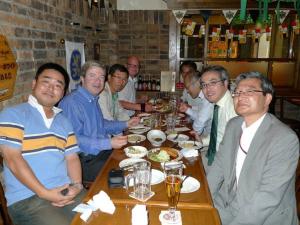Blanket remote handling R&D to restart in Japan
11 Jun 2010
-
Mario Merola, Head of the Internal Components Division
Getting together and enjoying Japanese food is the best way to end intensive working days and to consolidate friendship.
18 May 2010 was a date that the ITER blanket community will remember. Two critically-important "project change requests" (PCR) were accepted for implementation into the Baseline. They were originated by the ITER design review held in 2007 and confirmed by the blanket conceptual design review held in February this year.
PCR-076 addressed the concern that the beryllium-covered blanket first wall panels are unlikely to have sufficient lifetime under transient heat load events over the 20 years of ITER operation, therefore remote handling capability needs to be clearly demonstrated. This also opens the possibility of a full replacement of the first wall panels in the case of a change of armour material if and when decided.
PCR-077 addressed the new blanket design, namely the shaping of the first wall panels to protect the leading edges; the start-up and shut-down to be carried out on the first wall thereby eliminating the two start-up limiters; and the in-situ replacement of the panels. This latter feature also has important implications on the remote handling operations that will be developed to refurbish the blanket modules inside the vessel.
Following these new remote handling requirements, the importance of a realistic demonstration was pointed out to confirm the remote handling feasibility of the recently-developed FW panels. The Blanket Section, in close collaboration with the Remote Handling Section, has selected R&D items to be conducted in 2010-2011, according to technical priority. The identified items will be investigated by the Japanese Domestic Agency (JA-DA), which is responsible for the Procurement Arrangement of blanket remote handling via a Task Agreement specifically issued for this purpose.
The kick-off meeting for this R&D work was held in Naka, Japan, on 9 June, followed by a number of dedicated technical meetings between the ITER Organization and JA-DA. This is a critically important activity for blanket development, which will address specific remote handling issues like the feasibility of positioning the first wall within the limit of planned fabrication tolerance, the alignment of the cooling pipes which must be remotely cut and re-welded, as well as the required welding procedures. This activity is due to be completed in summer 2011.


